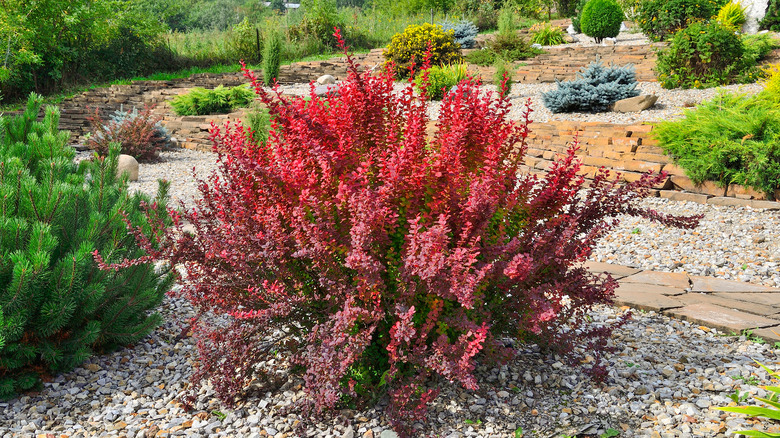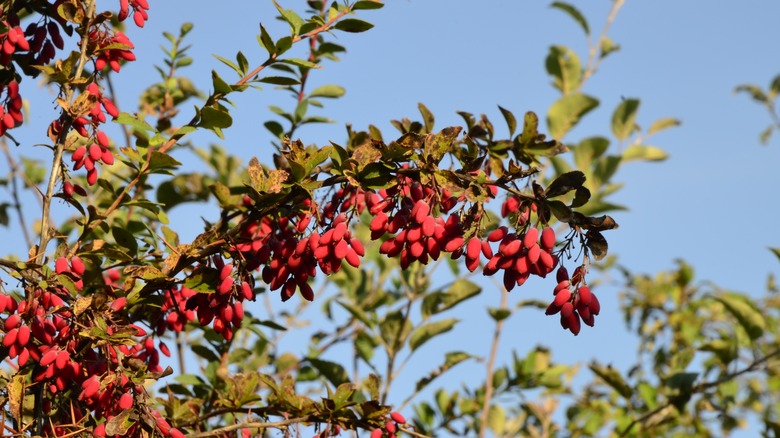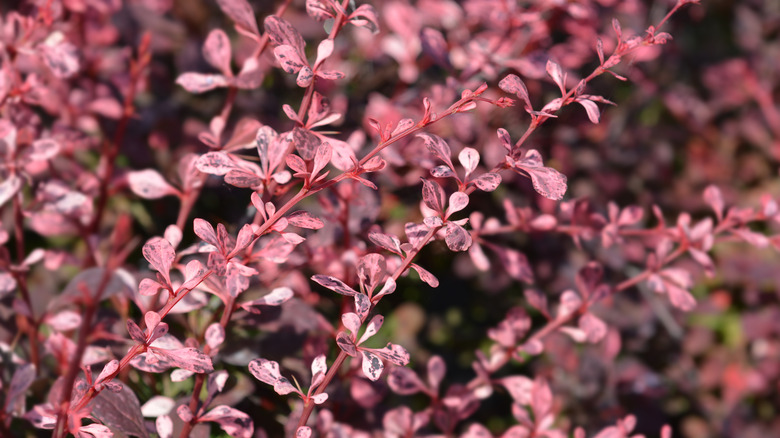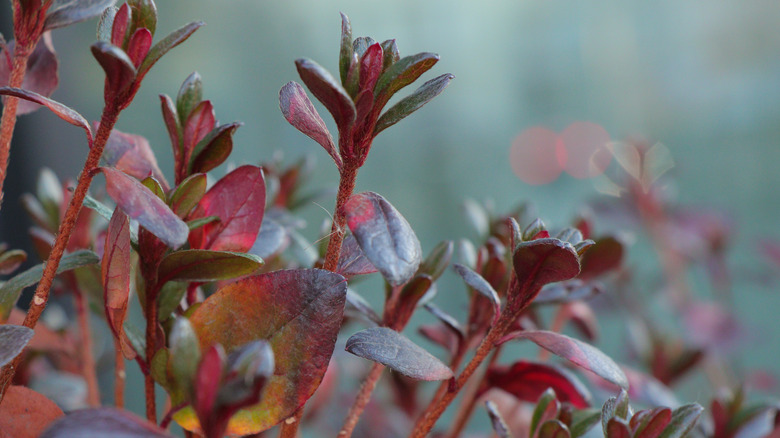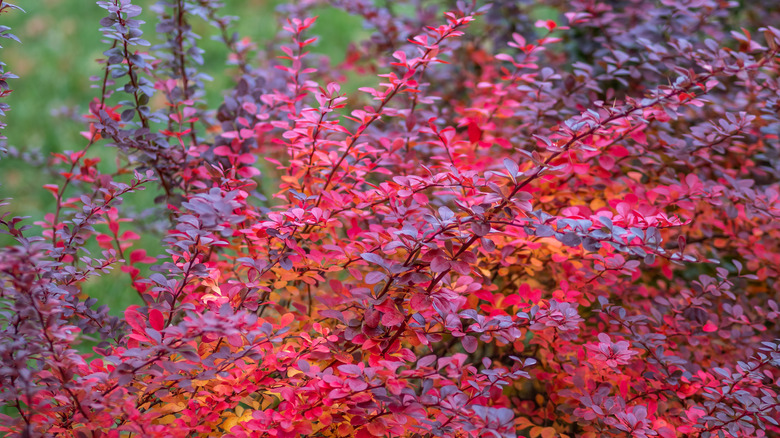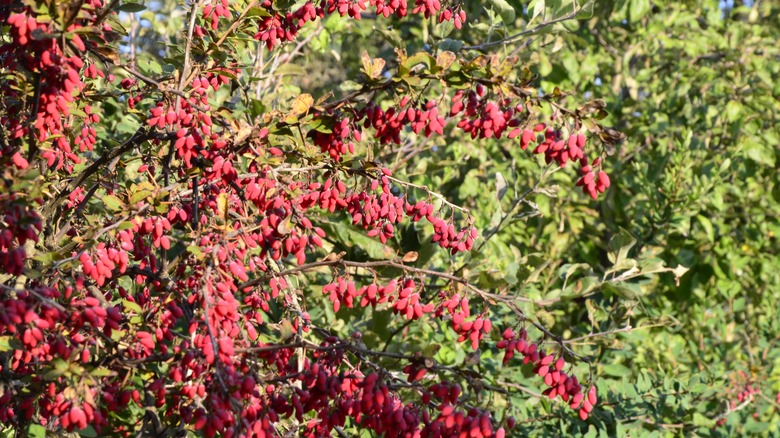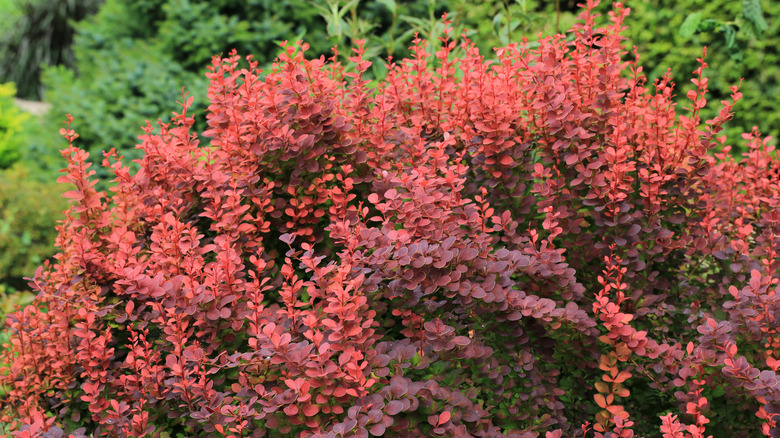How To Grow And Care For Barberry Shrubs
Barberry shrubs, or berberis vulgaris, are hardy, red or purple bushes found worldwide, per Nature and Garden. They produce flowers and berries, some of which are not only edible but even medicinal. There are hundreds of berberis varieties — some taller or shorter, with poisonous or edible berries, coming in different shades, etc. Most barberry bushes are thorny and attract nesting birds who find safety away from predators amongst the thorned leaves.
These shrubs are low maintenance and a popular choice for many landscaping projects. They are sustainable in urban environments, according to Gardening Know How, due to their ease of care. Barberry shrubs come in both evergreen and deciduous varieties and, as such, have a variety of uses and potential when used in designing your backyard.
Barberry shrubs are incredibly versatile plants. Barberry shrubs are a great addition to any yard with an array of varieties, beautiful colors that add to landscapes without overwhelming them, and low maintenance and easy care needs. Read on to learn how to grow and care for these plants.
How to use barberry shrub in garden
Barberry shrubs have a variety of practical and aesthetic uses in the garden. Due to their thorny leaves, they are naturally deer resistant and resistant to other wildlife. They are incredibly easy to care for and maintain, making them very versatile. One thing to consider before planting a barberry shrub, though, is that some species are invasive, particularly Northeast and Midwest America, according to The Spruce. Most grow in zones 4 to 8, but some varieties can handle warmer climates.
There are many practical uses for barberry shrubs, according to Monrovia. Due to their thorns, they are often used for privacy hedges. The thorns act as a natural gate to keep wandering wildlife out and domestic pets in. They grow densely and will easily aid in creating privacy. Monrovia also recommends planting them with conifers and hydrangeas. You can also use barberry shrubs to naturally defend gardens and flowers against wildlife. Consider planting multiple varieties of different colors together for a colorful display.
How to grow barberry shrub
Barberry shrubs are easy to grow, and the easiest way to get started is to purchase a young plant at your local nursery or garden center and transplant it to your garden early or late in the season, according to SF Gate, or maintain it in a pot.
You can also grow barberry bushes from seeds, which can be purchased or harvested. To sow the seeds, Masterclass recommends placing them in starter trays filled with one part soil, one part perlite. Make sure to keep the plant moist and at around 60 degrees, and the seeds will germinate in about a month. Replant in potting mix once they've grown roughly 3 inches, and they should be ready to transplant in the ground once they're at least a foot tall.
Barberry shrubs can also be grown via propagation. According to Gardening Know How, this will result in a shrub identical to its mother plant. Cut at least six inches off a healthy branch, and strip the bottom half of leaves, leaving the nodes intact. Apply rooting hormone powder to the cut bottom, and push into a pot full of wet sand. Mist the cutting and keep it covered in cling film to maintain moisture, watering when the sand gets dry. Check for roots after three weeks, and let grow another two weeks in the sand. Replant in a starter pot until it's a foot tall, then replant.
How to care for barberry bush
Caring for barberry shrubs is incredibly easy. They are tolerant of most light conditions, ranging from partial shade to full, direct sun, according to Gardening Know How – make sure to check with your specific variety, though. Per White Flower Farm, they only need light watering — once a week in the summer is fine, unless there's more than an inch of rain per week. Mulch around the base of the plant to help retain moisture. Barberry bushes don't like being waterlogged or too wet, and regular rainfall should be enough during the spring and fall.
Barberry bushes don't need regular fertilizing. Plants younger than a year old should not be fertilized. However, mature plants can benefit from being fed a 10-10-10 formula once a year.
The only semi-regular maintenance required for barberry shrubs is pruning about twice a year. Using clean pruning shears, prune to your desired shape, removing any dead branches or leaves. This will help the shrub keep a visually pleasing shape, as well as help keep it healthy and strong.
How to repot barberry bush
Barberry bushes can be grown both indoors and outdoors in pots. If the plant is considered invasive in your region, consider opting for a potted plant. According to Nature and Garden, barberry bushes will need to be repotted when they become root-bound and should be checked annually for overgrown roots. Repot every two to three years to encourage new growth and ensure nutrients are getting to the root system.
The biggest concern for a potted barberry shrub is being overwatered. In-ground shrubs usually maintain ideal moisture levels on their own through rain and ground moisture retention, but this is not the case for potted plants. When repotting, consider using a terracotta pot to help drain excess moisture. If potting indoors, consider placing it on a pebble tray to help with moisture retention. Use a well-draining potting mix. To encourage further drainage, consider mixing in sand or perlite to the soil.
Begin by removing the plant from its current pot. Assess the root system, and remove any damaged or rotten roots. Add a bit of soil to your pot, and position the plant, so it's at roughly the same height in the pot as it was before. Fill with soil and water to expose air pockets and fill any exposed gaps. Water again and let drain completely. Do not fertilize or overwater, as the roots and plant are in a more fragile space as it adjusts to its new home.
Barberry bush varieties
There are over 400 varieties of barberry shrubs, all with unique attributes and remarkably simple care needs. Some are more adept to warmer or colder climates, vary in colors, are larger or smaller. As a result, there is a variety of barberry for every garden. Here are just a few varieties from Meadows Farms:
- Helmond pillar barberry — This variety grows in upright columns and is identifiable by its dark maroon leaves and foliage.
- Tiny gold barberry — As the name suggests, this variety is smaller, only growing to about two feet tall (per Garden Debut), and has distinct golden foliage.
- Japanese barberry — Also known as rosy rocket, this variety is unique for its coral, pink, and red variegation, and columnar growth.
- Crimson pygmy — A dwarf variety of Japanese Barberry, this variety grows in small, round shrubs.
- Concorde barberry — This variety is one of the smallest, is found in a deep, wine-purple color, and is often used as an accent shrub in landscaping.
Is barberry bush toxic?
Barberry shrubs can be toxic, but they can also be edible and medicinal. This all depends on the variety, and before using barberry bush berries for consumption or treating a medical issue, ensure your variety is non-toxic and safe for consumption. Do not forage barberry berries unless you can guarantee what species it is.
According to Very Well Health, barberry bush berries contain something called berberine, which has a variety of health benefits. Berberine can be used to treat or alleviate symptoms of canker sores, diabetes, high cholesterol, high blood pressure, polycystic ovarian syndrome, and diarrhea and can be found in teas, capsules, tablets, topical cream, and extracts. Per Gardener's Path, barberry is also commonly used in Iranian pilaf and to flavor Russian candies. Consume in moderation.
Berberine is poisonous to animals, however. While they will likely not eat the bush because of its thorns, don't leave berberine supplements or harvested berries within reach of pets. According to Frontiers, symptoms of berberine poisoning in animals include diarrhea, excessive drooling or salivation, nausea, vomiting, shaking, and paralysis. Call the vet immediately if you suspect your animal has consumed barberry berries or berberine. And while deer do not eat the plant, it is a hiding place for deer ticks, per The Garden of Eating, which are a significant spreader of Lyme disease. Check yourself, children, and animals for ticks after being around the shrub.

